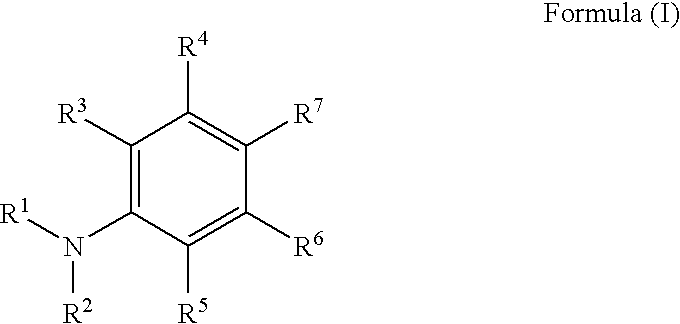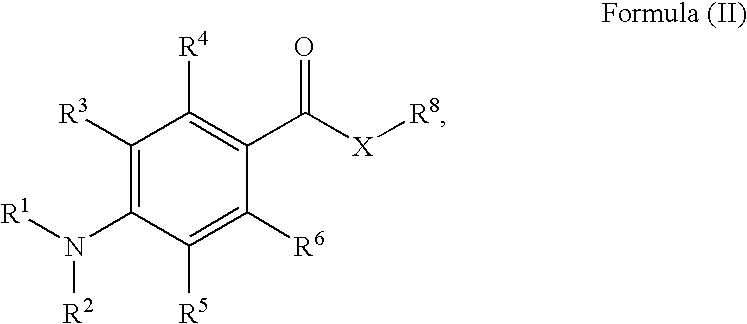Radiation curable compositions for food applications
a technology of compositions and radiation curables, applied in the field of radiation curable compositions, can solve the problems of significant reduction of curing speed and health risks, and achieve the effect of stable liquid radiation curable compositions
- Summary
- Abstract
- Description
- Claims
- Application Information
AI Technical Summary
Benefits of technology
Problems solved by technology
Method used
Image
Examples
example 1
[0251]This example illustrates the synthesis of co-initiators suitable in the radiation curable compositions and inkjet inks of the invention.
Co-Initiator COINI-1
[0252]The synthesis was performed according to the following scheme:
14.2 g (0.215 mol) of 85% KOH was dissolved in 100 mL ethanol. The temperature rose to 30° C. 30 g (0.178 mol) of 4-dimethylamino benzoic acid was added and the mixture was stirred for 90 minutes. The solvent was evaporated under reduced pressure. The residue was treated with 300 mL methyl tert. butyl ether, isolated by filtration and dried.
[0253]9.4 g (47 mmol) of 4-dimethylamino benzoic acid potassium salt was added to a solution of 10 g (56 mmol) of 2-bromoethyl acrylate in 40 mL dimethyl acetamide. 1 g of BHT was added and the mixture was heated to 60° C. for 2 hours. The reaction was allowed to cool down to room temperature. The formed potassium bromide was removed by filtration and 150 mL of methyl tert. butyl ether was added. The mixture was extracte...
example 2
[0264]This example illustrates the reduction in extractables of the photoinitiating system from liquid radiation curable compositions including a diffusion hindered photoinitiator and a polymerizable co-initiator according to the present invention. Preparation of liquid radiation curable compositions
[0265]The comparative liquid radiation curable compositions C-1 and C-2 and the inventive liquid radiation curable compositions INV-1 to INV-5 were prepared by mixing the components according to Table 5. The weight % (wt %) of the components were based on the total weight of the liquid radiation curable composition.
TABLE 5wt % ofINV-1INV-2INV-3INV-4INV-5C-1C-2DPGDA39.027.034.542.541.545.043.5TMPTA40.040.040.040.040.040.040.0INI-B118.0——————INI-B11—20.0—————INI-B5——15.0————INI-C12———10.0———INI-C13————10.0——Comp-————— 7.0—INI-1Comp-—————— 7.5INI-2COINI-1 9.511.0 8.5 5.5 6.5——Comp-————— 6.0 7.0COINI-1Dibutyl 2.0 2.0 2.0 2.0 2.0 2.0 2.0phtalate
[0266]The following compounds were used as compa...
example 3
[0281]This example illustrates the good shelf-life (dispersion stability) of an ink prepared in accordance with the present invention, using the aromatic tertiary amine in stead of an aliphatic tertiary amine.
Preparation of Comparative Initiator Comp-INI-3
[0282]The comparative initiator Comp-INI-3 was prepared according to the following synthesis scheme:
To a solution of 2-[2-(2-methoxyethoxy)ethoxy]acetic acid (2.7 g, 0.015 mol) in N,N-dimethylacetamide (50 mL), 1,1-carbonyldiimidazole (3.3 g, 0.0165 mol) was added in portions. The reaction mixture was allowed to stir for 30 minutes at room temperature resulting in the formation of the imidazole intermediate.
[0283]IRGACURE™ 2959 (3.4 g, 0.015 mol) was added and the mixture was stirred for about 48 hours at room temperature.
[0284]The reaction mixture was cooled to −10° C., diluted with distilled water (100 mL) and extracted with methyl-tert-butylether (2×150 mL). The organic layer was separated and dried over MgSO4.
[0285]After evapor...
PUM
| Property | Measurement | Unit |
|---|---|---|
| Composition | aaaaa | aaaaa |
| Whiteness | aaaaa | aaaaa |
Abstract
Description
Claims
Application Information
 Login to View More
Login to View More - R&D
- Intellectual Property
- Life Sciences
- Materials
- Tech Scout
- Unparalleled Data Quality
- Higher Quality Content
- 60% Fewer Hallucinations
Browse by: Latest US Patents, China's latest patents, Technical Efficacy Thesaurus, Application Domain, Technology Topic, Popular Technical Reports.
© 2025 PatSnap. All rights reserved.Legal|Privacy policy|Modern Slavery Act Transparency Statement|Sitemap|About US| Contact US: help@patsnap.com



